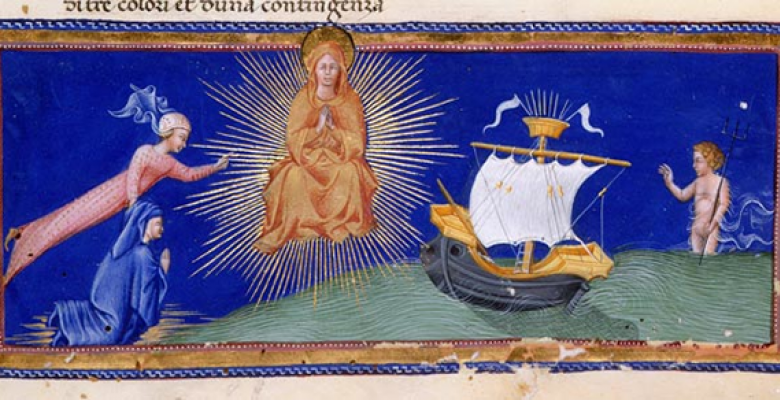Italian Professor Redesigns a Dante Primer for the Digital Era

Eliot did not name the author, leaving Barolini to wonder at the source. “I felt the poetic enchantment almost immediately.”
Dante does that to people, as Barolini, the Lorenzo Da Ponte Professor of Italian, has found over a long career as a renowned Dante scholar. Even in his own time, “people immediately started trying to communicate what Dante did in ways beyond the written word,” she said, using different media to communicate what she calls his “virtual reality.”
One can see it in the intricate drawings of the Commedia by Dante’s contemporary, Sandro Botticelli, in Salvador Dali’s 20th century woodcuts and in Da Vinci Code author Dan Brown’s novel Inferno. There’s even an Inferno video game.
Now Barolini, along with several current and former students and collaborators across the University, has adapted Dante to the classic medium of the modern age.
Columbia’s Digital Dante is a relaunch of an initiative that began two decades ago—in the early years of the Web—by Jennifer Hogan, then a Ph.D. student at Teachers College. She was documenting a new project at a private school that connected fourth graders with experts at the Louvre who simulated a virtual archeological dig.
“The kids loved it,” Hogan recalls. “It was clear there was going to be this ubiquitous access to resources.” Part of her thesis explored how the tool could be used in public schools. She chose Dante because he wrote in the vernacular and because she knew there were many images to illustrate the text. She also wanted to experiment with hypertext, the then-revolutionary idea that clicking on specific words could take you to a new page of information elsewhere on the site.
“My vision was to put up as many resources as I could,” she says. “And then engage a scholar to advise and mentor through the Web.”
Hogan discovered her Dante expert across campus in the Italian Department. Barolini is the first to admit that 20 years ago, she wasn’t quite sure what to make of Hogan’s idea, but was won over by her enthusiasm. Hogan enrolled in her yearlong Dante class and spent a summer in Italy.
Initially, Hogan used a translation by the 19th century poet Henry Wadsworth Longfellow. Later, at Barolini’s suggestion, she added a well-regarded modern translation by the poet Allen Mandelbaum and hyperlinks to notes and interesting images. The professor and her graduate students answered questions that flooded into the site.
Eventually, Hogan earned her Ph.D. and moved on. Although the site sat dormant, scholars kept using it even as the links fell into disuse and took them to unrelated websites. Then one day, Barolini received an email from a colleague at the University of Chicago who had clicked on one of the site’s links while teaching a class, and up popped a pornographic website.
So in 2011 Barolini and her collaborators decided to revive and expand Digital Dante. She reconnected with Hogan, who helped recruit Rebecca Kennison, the former director of Columbia Libraries/Information Services’ Center for Digital Research and Scholarship, and its current interim director, Mark Newton, to update the site to conform to modern Web design standards. The team, which by then included developer and designer Jackson Harvell as well as Meredith Levin, a humanities and history librarian, added new features, like a canto-by-canto commentary of 139,380 words, or almost 600 pages. It was written by Barolini in a more casual style than she uses in her scholarly writing.
“I got into the fact that it is digital and that it can change and that I can explore ideas by looking into it myself or letting somebody else investigate it,’” she says. “I like the idea of starting conversations and making people think.”
The site now contains a number of rare prints from Columbia’s Rare Book and Manuscript collection. They include three editions of the Commedia: from 1487, 1544 and a third with detailed maps from 1568.
It also showcases the work of past, present and future graduate students. One of them, Julie Van Peteghem, an assistant professor in Italian studies at Hunter College, played a crucial role, working with the team to expand part of her thesis—comparative analysis of the Commedia and Metamorphoses—into the project. The resulting “Intertextual Dante” features Dante’s work on one side of the screen and Ovid’s poetry on the other.
“We saw a great opportunity to do something new—to update it for a new generation,” says Akash Kumar, a former graduate student and Core Lecturer who now serves as the site’s managing editor. “We’re talking about something that has been read now for almost seven centuries.”
Digital Dante can be explored at digitaldante.columbia.edu.